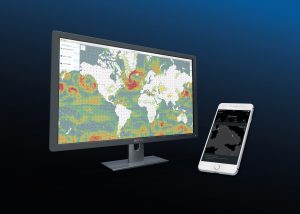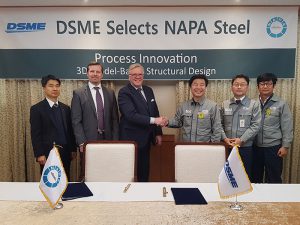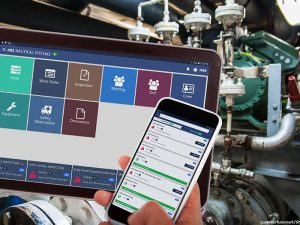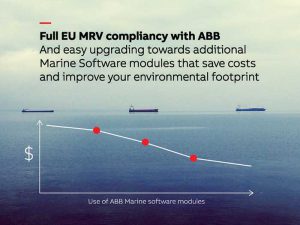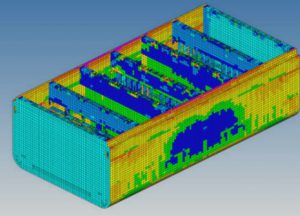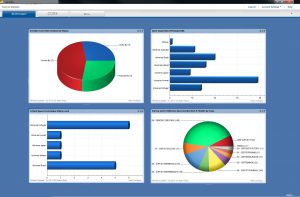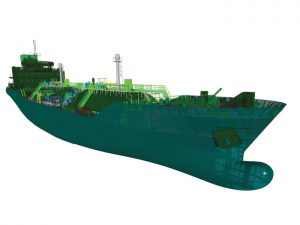To mitigate the shipping industry’s contraction, Spanish engineering firm GHENOVA Ingeniería, Seville, Spain, has seized opportunities in the high-growth markets of Latin America. A key project enabling them to establish a strong foothold is the design of a fleet of LPG tankers for Transpetro, using AVEVA Marine.
According to Ignacio Grau, GHENOVA’s Head of Marketing and Communication, the naval sector has been GHENOVA’s core market since the company’s founding. However, several projects signed in Brazil, both for naval engineering and energy, are now expanding the company’s client base. As a Spanish company, GHENOVA has a head start.
“For us, expansion into Latin America was a natural choice,” says Julián Fontela, GHENOVA’s Manager of Business Development. “We have fewer linguistic or cultural barriers to entry than equivalent North American or other Anglophone companies.”
The depressed shipping market following the slump in 2008 especially impacted GHENOVA’s customer base in Europe and in the naval sector; the company recognized the need to pursue new opportunities in high-growth markets. “Our main office in Latin America is in Brazil, and from there we are orchestrating our expansion into the rest of Latin America,” explains Julián. “Projects executed from the Brazilian office are of strategic importance for us, because each one demonstrates both the high quality of our work and our long-term commitment to our customers in the region as a whole. This strategy really represents a key ingredient for the growth of the company.”
Adds Ignacio, “The focus on both Europe and Latin America has meant intensified activities and a resulting notable staff increment, which are cornerstones of a longer-term growth strategy: we want to reach EURO 50 million in annual revenue and significantly increase our workforce by 2018.”
LPG tanker engineering
In September 2011, a year after GHENOVA first entered Brazil, success came with the signing of a EURO 7 million contract with the STX Promar shipyard (now Vard, part of the Fincantieri group) to carry out the engineering of eight LPG tankers for Transpetro. A subsidiary of Petrobras, Transpetro is Brazil’s largest oil & gas distribution company. It stores and transports oil, ethanol, biofuels and natural gas, and has a network of more than 11,000 kilometers (7,000 miles) of pipelines.
“Our Brazil office is very strong on the marine side and the LPG project is a great reference case,” says Julián. “It clearly demonstrates our capabilities to neighboring countries who are also important oil & gas players on the global stage. We hope that this project will be a springboard for GHENOVA to foster relationships with other oil & gas producers in the region.”
The project consists of the detailed engineering and purchasing support for the prototypes of three LPG carrier designs. A design for four vessels with a pressurized capacity of 7,000 m3 has already been delivered. The first three are already in fabrication. The first vessel in the series has been christened Oscar Niemeyer and will be delivered in December 2014. A further vessel design for two LPGs with a smaller pressurized capacity of 4,000m3 is also complete; at the time of writing, both vessels are being constructed and will be delivered soon. GHENOVA is now working on a design for two semi-pressurized vessels that will each have a capacity of 12,000 m3. GHENOVA is responsible for all the detailed engineering of the structures, piping, equipment and outfitting, the electrical, instrumentation and electronics systems, and HVAC and accommodation. The Brazilian team are using AVEVA Hull, AVEVA Outfitting, and AVEVA Cable Design, collaborating with their colleagues at the Spanish headquarters with the help of AVEVA Global.
The business opportunity
This high-profile project provided an excellent opportunity for GHENOVA to establish a reputation with Petrobras. A link to Petrobras is an endorsement of GHENOVA’s capabilities and sends a strong message to other organizations in the region. Furthermore, GHENOVA has established a connection with this Brazilian oil & gas giant at a crucial time in Petrobras’s history. The offshore Santos Basin discovery means that Petrobras will invest in fleet expansion and renewal to support its future increase in E&P activities and, as a result, there will be opportunities for further projects.
Another key factor that will push forward growth in this market is the Certificado de Registro e Classificação Cadastral (CRCC) certificate, which is awarded by Petrobras to companies that meet all the requirements to become an approved services provider. The CRCC specifically certifies GHENOVA’s ability to carry out comprehensive shipbuilding and tanker-ship projects.
This document allows GHENOVA to tender and participate in bids for work from Petrobras and, combined with the LPG project, marks a significant step forward. GHENOVA describes it as its “passport” into the Brazilian market.
Selecting the right tool for the job
To make the most of this business opportunity, GHENOVA needed the best tool for the job. With previous experience with Tribon, GHENOVA had successfully adapted to AVEVA Marine several years ago and is very happy with the result; their designers and engineers were able to adjust quickly and smoothly to the new system. Their AVEVA deployment forms part of a suite of applications that enables GHENOVA to meet a wide range of client- and project-specific requirements. As a result, GHENOVA selects the design software on a case-by-case basis. “Our business is engineering, first and foremost,” says Julián. “Each of the different types of software that we use is one system within a diverse toolkit. Every client has different requirements and meeting those requirements is key. We don’t only design ships; among other things we also design thermal power plants, so our choice of software for any particular project is usually dictated by the nature of the project and the client’s requirements.”
As a result, AVEVA Marine was chosen specifically for this project because it best matched Transpetro’s needs and was consequently mandated by Vard Brazil. “This is an entirely new project for us, so it was essential to select a 3D engineering and design tool that could deliver true strategic value,” explains Francisco Cuervas, General Director of GHENOVA. “AVEVA Marine met all the requirements that the client set out, making it the ideal choice for such an important project. The integrated AVEVA Marine applications have helped us to save many hours during the design phase, allowing an efficient and accurate model to be delivered to our customer.”
Rui Miguel de Sousa, GHENOVA Brazil’s Branch Director, says, “The AVEVA solution was subjected to a rigorous tender process and its integrated hull and outfitting design capability stood out against the competition. It will enable us to efficiently create clash-free, production-oriented design. We are confident this will help us achieve reduced rework and deliver the highest quality designs. With concurrent global project execution we can also ensure that all sites and users have access to the latest approved data, right down to attribute details.”
“We will continue to use AVEVA Marine as part of an overall service offering as we continue to seek out opportunities in both our European client base, and our expanding new client base in Latin America,” says Julián.

